NEMA vs. IP: Differences Explained

In the sphere of electrical engineering, two key rating systems, NEMA (National Electrical Manufacturers Association) and IP (Ingress Protection), determine the level of protection offered by electrical enclosures against varying environmental conditions that could jeopardize their functionality.
These ratings are utilized across diverse fields such as commercial, industrial, and consumer goods, as well as specialized electrical equipment and enclosures. Both these rating systems serve distinct regions, with NEMA being dominant in North America, and IP recognized globally.
Significance of NEMA and IP Ratings for PCBAs Designers
For engineers who design printed circuit board assemblies (PCBAs), grasping the nuances of NEMA and IP ratings is pivotal for several reasons:
- Environmental Protection: These ratings provide insights into the protection levels that enclosures offer against environmental threats like moisture, dust, and corrosive substances, thus guiding engineers in choosing the right enclosure to safeguard the PCBA.
- Industry Standards Adherence: By understanding NEMA and IP ratings, engineers can design PCBAs that meet industry-specific standards for protection against environmental factors.
- Safety and Dependability: In high-stakes environments (such as aerospace, military, and medical), understanding NEMA and IP ratings assists engineers in selecting the best enclosure that ensures the PCBA's reliable operation.
- Cost Efficiency: Selecting an appropriate enclosure with the right NEMA or IP rating helps prevent PCBA damage, circumventing the need for costly repairs or replacements.
Despite being separate rating systems, NEMA and IP ratings do share rough equivalences. For example, NEMA 4 often correlates with IP66 for water resistance, while NEMA 12 is comparable to IP54 for solid object resistance. However, these comparisons aren't exact, and one should reference the specific NEMA and IP rating requirements to fully comprehend the protection a device offers.
Impact of Incorrect Rating Selection
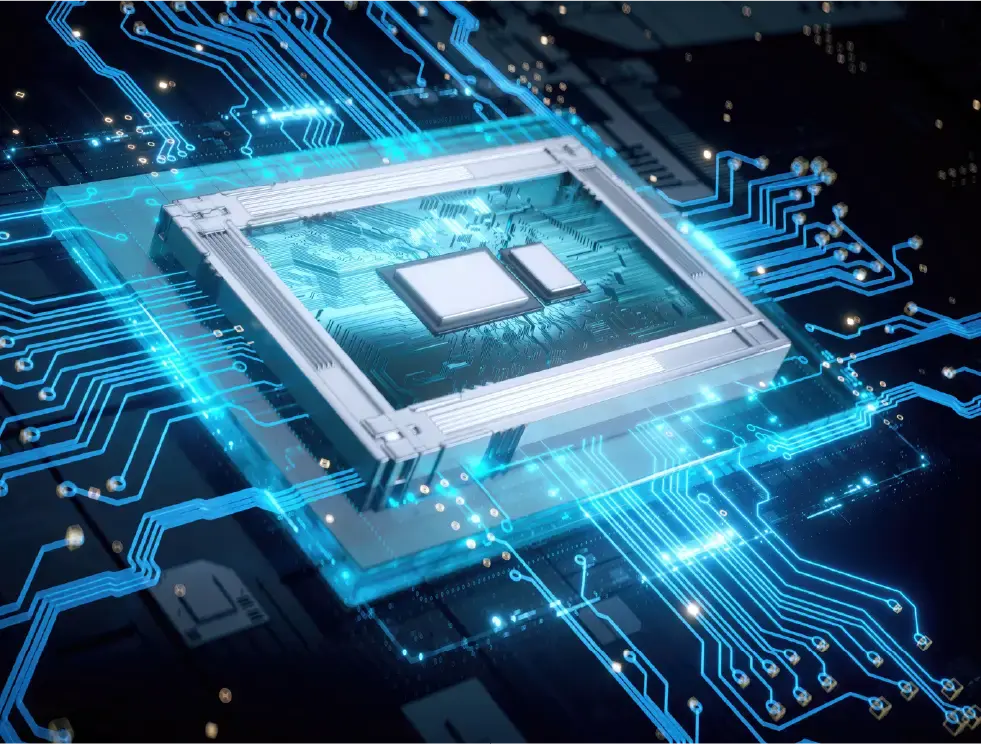
Choosing an inappropriate IP or NEMA rating can have detrimental outcomes, including equipment damage, safety risks, non-compliance with industry standards, escalated costs, and diminished reliability. Therefore, understanding environmental factors and industry norms is essential for appropriate rating selection.
This blog post delves into the definitions, origins, purposes, and advantages of NEMA and IP ratings.
Understanding NEMA Ratings in Electrical Engineering
NEMA ratings provide a standard to measure the protection level an enclosure offers against environmental factors like moisture, dust, and corrosive elements.
Origin and Evolution of NEMA Ratings
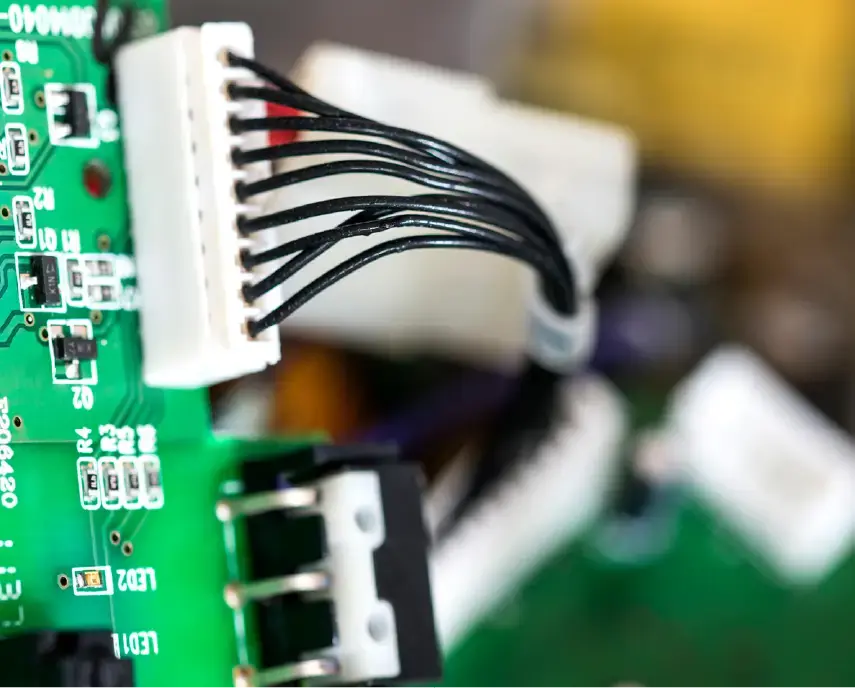
Founded in 1926, NEMA ratings have evolved over time to include a broad spectrum of ratings and requirements. The original four NEMA ratings (NEMA 1, 2, 3, and 4) primarily dealt with protection against water, oil, and dust. However, as demand for specialized enclosures rose, additional NEMA ratings were introduced. For example, the NEMA 12 rating provides protection against dripping water, dust, and oil, while NEMA 13 safeguards against spraying water, dust, and oil.
Role of NEMA Ratings in Ensuring Safety and Reliability
NEMA ratings guide the selection of the right enclosure based on its protective capabilities against environmental factors, thus ensuring the safety and reliability of electrical devices. Proper selection based on NEMA ratings minimizes the risk of failure or damage due to environmental exposure and promotes equipment performance, reliability, and user safety.
NEMA Ratings Classification
Here's a quick rundown of the most common NEMA ratings:
- NEMA 1: Protects against solid objects like tools and fingers, but lacks water- or liquid-proof capabilities.
- NEMA 2: Offers protection against falling items and solid objects.
- NEMA 3: This rain-tight enclosure withstands weather exposure, but it's not designed for outdoor use or immersion in water.
- NEMA 3R: Similar to NEMA 3 but provides protection from rain, snow, and sleet, suitable for outdoor use.
- NEMA 4: The enclosure is water-tight and can withstand water sprays, making it suitable for wash-down or outdoor environments.
- NEMA 4X: This rating is equivalent to NEMA 4 but offers enhanced protection from corrosion and is designed for extreme outdoor conditions.
- NEMA 5: Protects against lint, dust, and other tiny particles, suitable for indoor applications.
- NEMA 6: Suitable for environments where brief immersion in water is possible.
- NEMA 6P: Similar to NEMA 6 but provides continuous immersion in water protection.
- NEMA 12: Designed for interior industrial environments, it protects against dust, dirt, and pouring liquids.
- NEMA 13: Offers similar protection to NEMA 12, but suitable for environments where liquid splashback is a possibility.
Products rated under the NEMA system include electrical junction boxes, cabinets and enclosures, disconnect switches, motor control centers, conduit and fittings, distribution panels, transformers and switchgear, HVAC equipment enclosures, industrial and commercial lighting fixtures, and communication equipment cabinets.
NEMA-rated products offer several benefits:
- Environmental Protection: They protect from environmental factors, ensuring reliable operation in diverse conditions.
- Safety: They shield from accidental contact with live electrical components.
- Compliance: Many industries mandate NEMA compliance for certain products.
- Longevity: They help extend the lifespan of the equipment.
- Standardization: They aid in maintaining consistency across products and manufacturers.
IP Ratings: What Are They and What Do They Mean?
IP ratings, short for Ingress Protection ratings, define the levels of sealing effectiveness of electrical enclosures against intrusion from foreign bodies (tools, dirt, etc.) and moisture. These ratings are standardized by the International Electrotechnical Commission (IEC). They provide a more detailed grading system than NEMA ratings, letting users know the exact degree of protection that the enclosure offers.
Origin and Evolution

The International Electrotechnical Commission (IEC) paved the way for standardized enclosure protection with the inception of the IP rating system in 1976. It utilized two digits to represent the level of protection against solid objects and liquids. This system was revolutionary as it offered a uniform method to rate enclosures for their resilience against specific environmental conditions.
In 1989, understanding the need for further detailing, the IEC augmented the system with a third optional digit to denote protection from mechanical impacts, such as shocks or collisions. This addition was vital in industries where equipment might face harsh physical conditions.
To keep up with the evolving industry needs, in 2001, the IEC undertook a comprehensive revision of the IP rating system. This update aimed to provide more nuanced information about the degree of protection offered by enclosures, effectively addressing a broader range of environmental conditions. The updated system also introduced new testing methods that allowed for a more accurate and reliable evaluation of the enclosures, ensuring their resilience under various circumstances.
How IP Ratings are Used

Electrical engineers use IP ratings to certify the safety and reliability of their equipment. An IP rating standardizes the level of protection provided by an enclosure against environmental elements like dust, water, and mechanical impacts.
Choosing electrical equipment with the right IP rating ensures it can withstand the environmental conditions it will encounter. For instance, a submersible pump with an IP68 rating is reliable in a wet environment, while an outdoor lighting fixture with an IP65 rating can resist dust and rain.
Using IP-rated devices not only protects the equipment itself but also enhances safety for those using or working around it. Using an IP-rated enclosure can help prevent unintended contact with live electrical components, reducing the risk of electrical shock and other accidents.
IP Rating Types and Meanings?
IP ratings come in various forms, with each one indicating a different level of protection. Here is what the digits in an IP rating mean:
The first digit (0-6) shows the protection level from solid objects:
- 0: No protection
- 1: Protection from objects larger than 50 mm
- 2: Protection from objects larger than 12.5 mm
- 3: Protection from objects larger than 2.5 mm
- 4: Protection from objects larger than 1 mm
- 5: Limited dust protection
- 6: Full dust protection
The second digit (0-9) shows the protection level from liquids:
- 0: No protection
- 1: Protection from vertical water drops
- 2: Protection from water spray up to 15 degrees from vertical
- 3: Protection from water spray up to 60 degrees from vertical
- 4: Protection from water splashes from any direction
- 5: Protection from low-pressure water jets from any direction
- 6: Protection from high-pressure water jets from any direction
- 7: Protection from immersion up to 1 meter for 30 minutes
- 8: Protection from prolonged immersion in water deeper than 1 meter
- 9: Protection from high-temperature, high-pressure water jets and/or other abrasive cleaning procedures
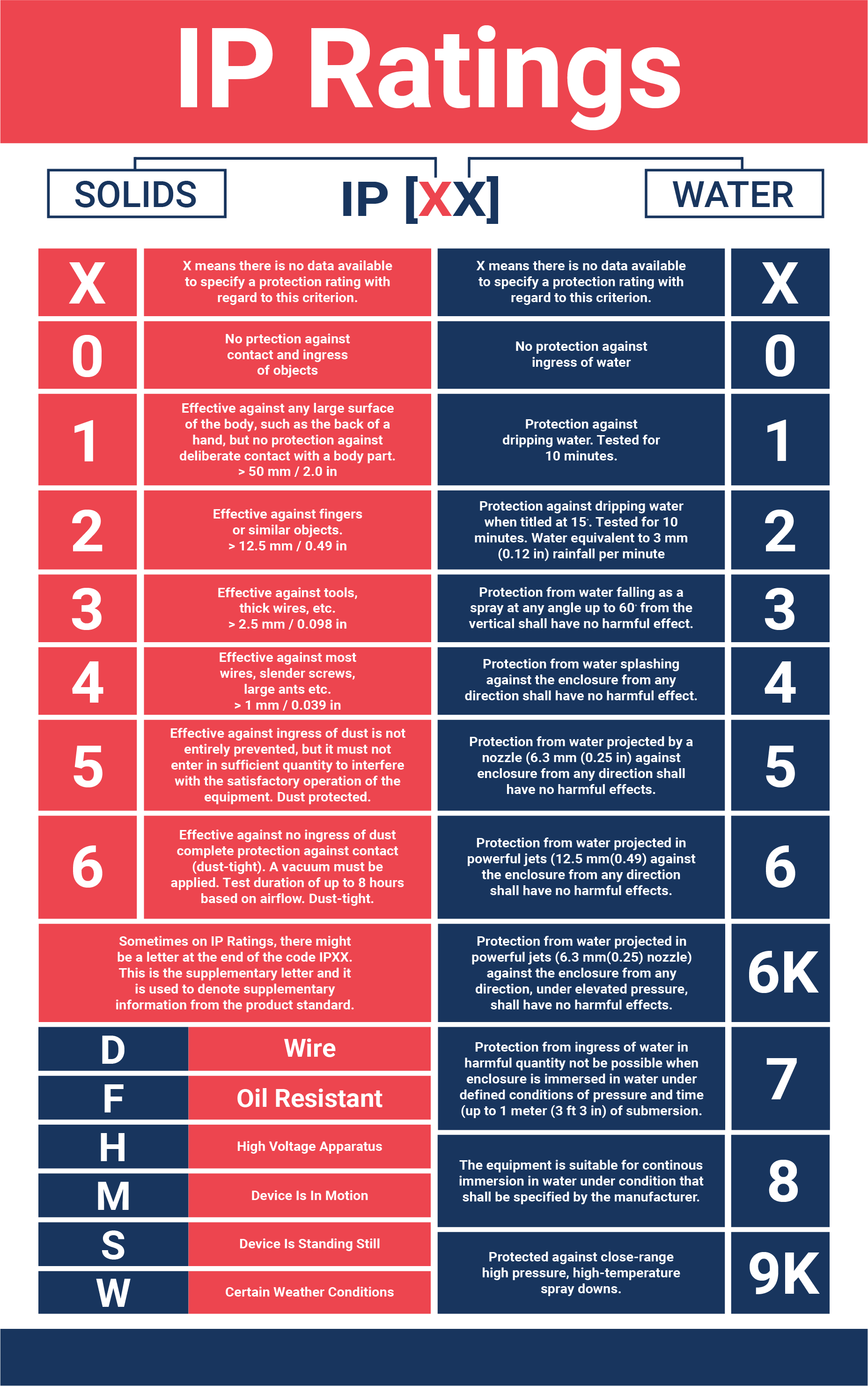
Source: Clarion Security Systems
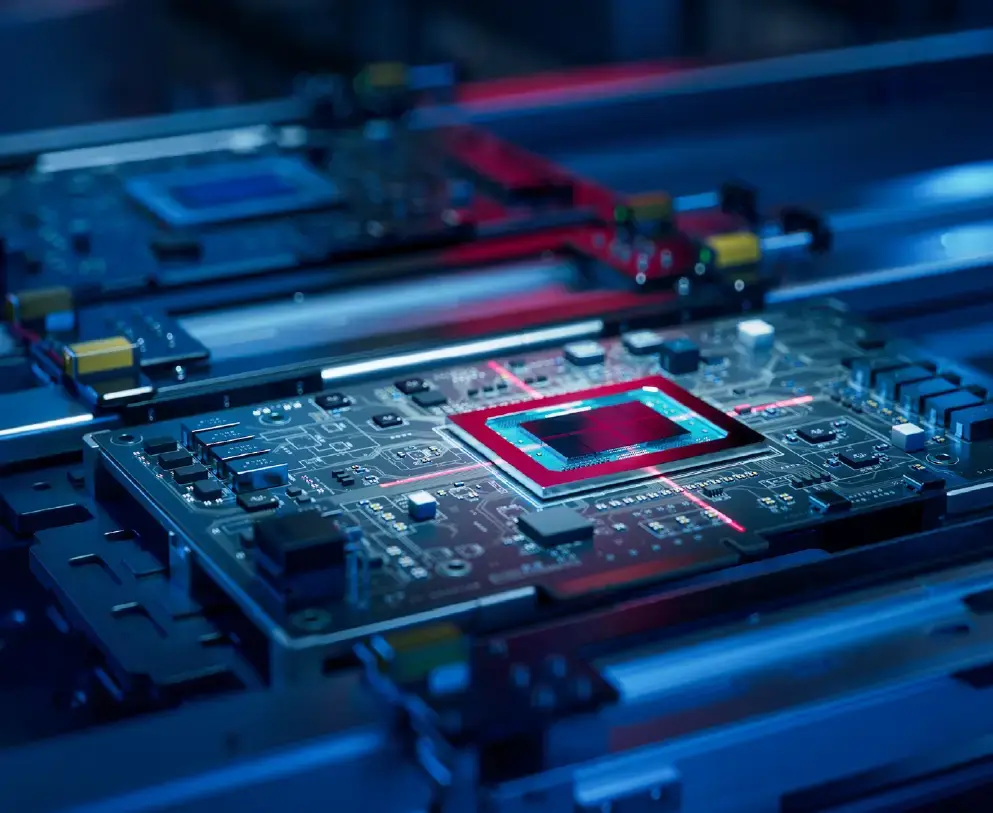
Bringing an additional layer of nuance, an optional third digit (0-9) in the IP rating system evaluates a device's resilience against mechanical impacts. However, this specification appears only when a product is intentionally designed to handle such physical stresses, thereby indicating its durability.
Products with IP ratings include smartphones, watches, speakers, cameras, outdoor lighting fixtures, industrial equipment, medical devices, electrical outlets, and HVAC systems, to name just a few.
The benefits of using IP-rated products are vast. For one, they offer protection from dust and dirt, increasing the product's lifespan and decreasing the need for regular maintenance and cleaning.
Similarly, IP-rated products are designed to withstand varying levels of moisture, making them suitable for use in environments where they might be exposed to water, such as in outdoor settings or specific industrial environments. This moisture resistance can significantly enhance the product's performance in harsh or challenging conditions.
Furthermore, using IP-rated products can result in lower repair costs, as these products are less likely to suffer damage from environmental factors, thus reducing the frequency of necessary repairs. In addition, IP-rated products meet regulatory requirements, ensuring compliance and safety for users.
In essence, IP ratings provide a clear and standardized way to determine the degree of protection a product offers, allowing consumers and professionals alike to make informed decisions when selecting electrical equipment. This level of transparency promotes safety, reliability, and efficiency in the electrical engineering industry.
Differences Between NEMA and IP Ratings
Checkpoint
It is common for electrical devices to be rated under both systems, which provide comprehensive protection while meeting various global standards
Understanding the differences between NEMA and IP ratings is fundamental to choosing the appropriate rating for a particular product or application. Both NEMA and IP ratings are utilized to measure the level of protection offered by electrical enclosures against environmental hazards. While NEMA ratings predominantly focus on safety aspects and are widely accepted in North America, IP ratings are more concerned with protection against moisture and solid objects and are recognized globally.
It is common for electrical devices to be rated under both systems, which provide comprehensive protection while meeting various global standards. Examples of such products include electrical enclosures, lighting fixtures, power distribution equipment, motor control centers, process control equipment, and marine electronics.
When to Use NEMA and IP Ratings

The application of NEMA or IP ratings depends on the specific needs of the environment or application. For instance, NEMA ratings are preferred in industrial environments, outdoor spaces, and marine environments, amongst others, primarily to protect individuals from electrical risks and safeguard equipment against varying environmental conditions.
IP ratings, conversely, are commonly used for consumer electronics, medical equipment, and outdoor lighting, among other applications, where there is a need to protect electrical equipment against solid objects and moisture.
When designing a PCB, the choice between NEMA and IP ratings would hinge on its intended use and environmental circumstances. While both systems are not directly interchangeable, understanding the specific needs of the application is crucial in deciding the most suitable rating system.
Conclusion
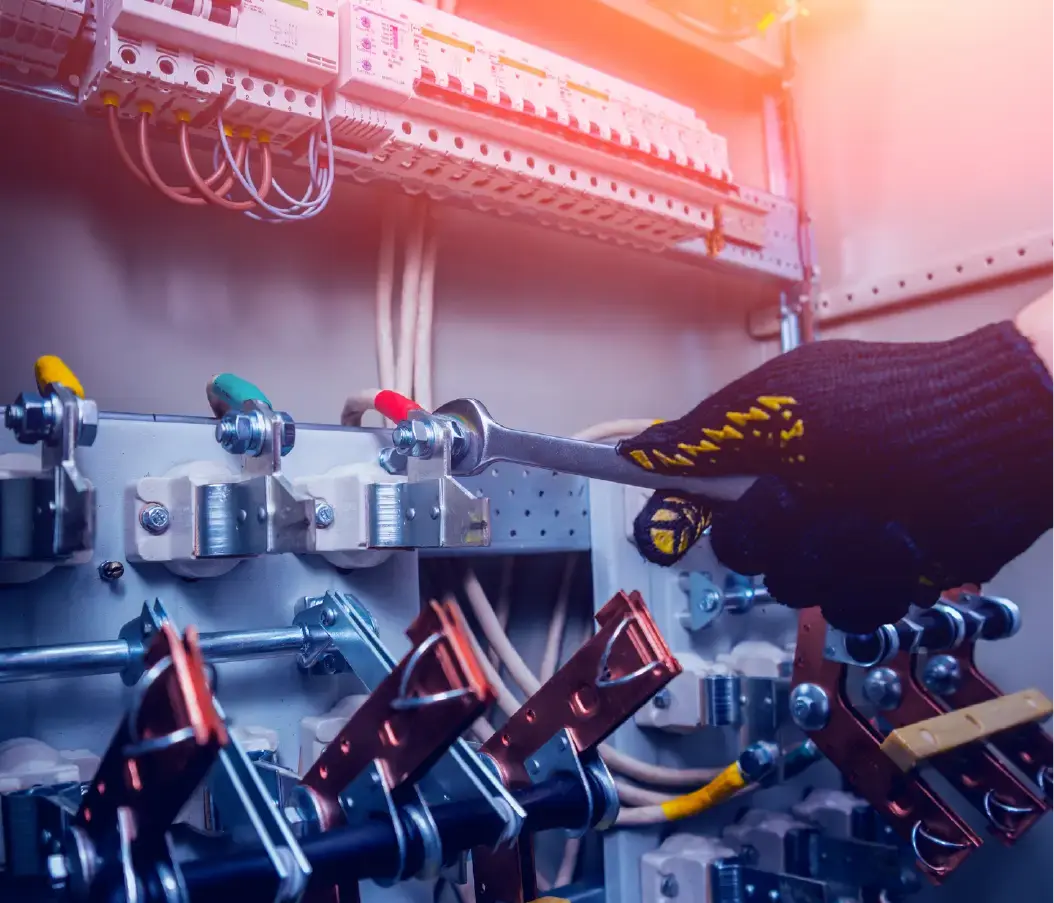
In conclusion, both NEMA and IP rating systems offer vital standardized frameworks for gauging the level of protection that electrical enclosures provide against various environmental hazards. Predominantly used in North America, NEMA ratings encompass broader safety aspects, considering factors such as corrosion, gasket aging, and hazardous environments. On the contrary, IP ratings, employed internationally, concentrate on guarding the internal components against intrusion from moisture and solid objects.
The understanding and application of these contrasting systems bear immense significance to electrical engineers, product developers, and end-users. They inform the design and selection of products or equipment, ensuring optimal protection relative to their intended environment. Additionally, they guide compliance with industry regulations like the NEC in the U.S. and the IEC internationally, promoting standardized safety and reliability.
Essentially, the thorough comprehension of NEMA and IP ratings and the nuances distinguishing them underpin the safety, reliability, and efficiency of electrical products and systems in diverse applications and settings. By offering a measure of protection that is universally recognized, these rating systems not only boost the overall quality of products but also elevate safety standards within the electrical engineering industry, ultimately facilitating the development of more robust, reliable, and cost-effective electronic devices.
Related Topics
Factories Fill Idle Capacity with EMS Marketplaces
How smart PCB assembly factories use digital EMS marketplaces like MacroFab to fill idle capacity, boost utilization, and grow revenue effortlessly.
Lock In Your Build Price with Tariff Protection
No surprises at checkout. Learn how MacroFab’s Tariff Protection keeps your build costs stable—even when global tariffs spike
11 Reasons Engineers Are Moving to US PCB Manufacturers Like MacroFab
Discover why engineers are shifting from offshore to US PCB manufacturers. Learn how MacroFab delivers faster, tariff-reduced, high-quality PCB assembly
Let MacroFab take care of your enclosure needs.
MacroFab Box-Build Assembly ServicesAbout MacroFab
MacroFab offers comprehensive manufacturing solutions, from your smallest prototyping orders to your largest production needs. Our factory network locations are strategically located across North America, ensuring that we have the flexibility to provide capacity when and where you need it most.
Experience the future of EMS manufacturing with our state-of-the-art technology platform and cutting-edge digital supply chain solutions. At MacroFab, we ensure that your electronics are produced faster, more efficiently, and with fewer logistic problems than ever before.
Take advantage of AI-enabled sourcing opportunities and employ expert teams who are connected through a user-friendly technology platform. Discover how streamlined electronics manufacturing can benefit your business by contacting us today.